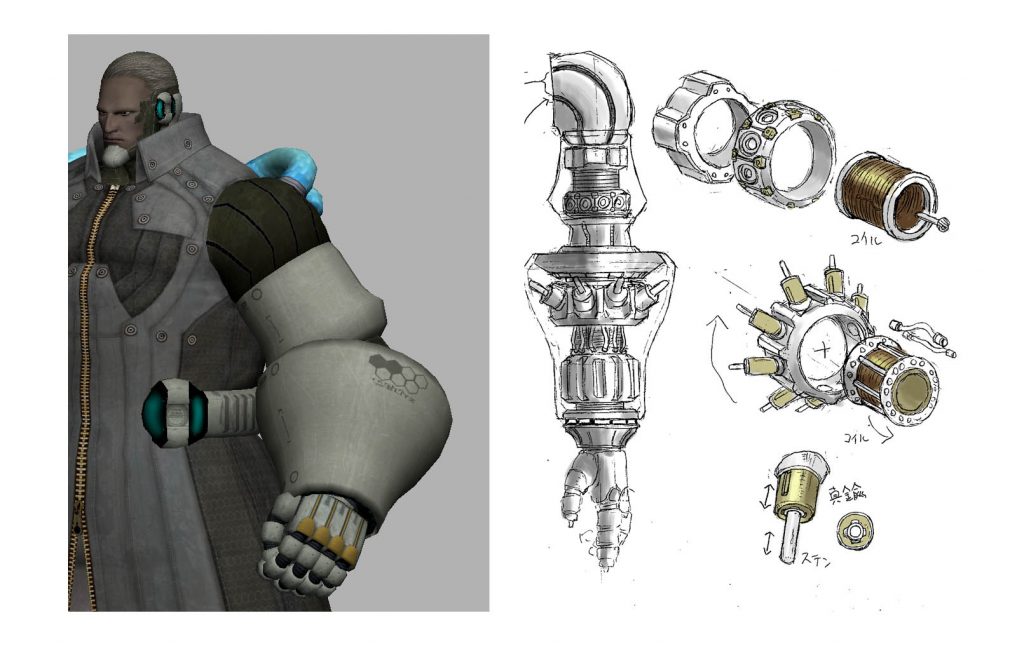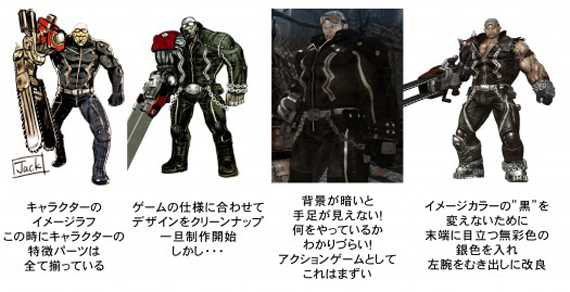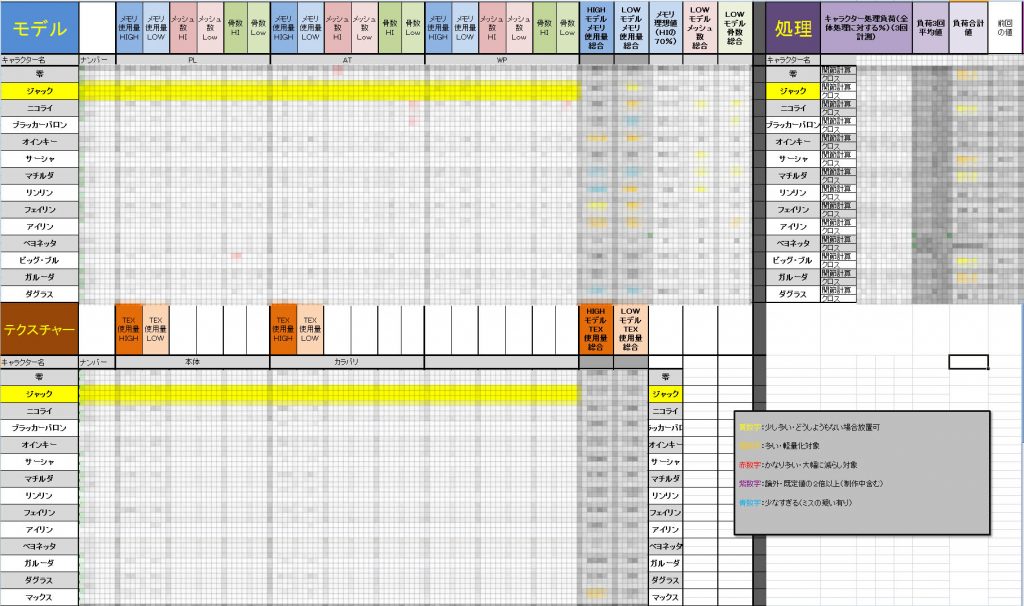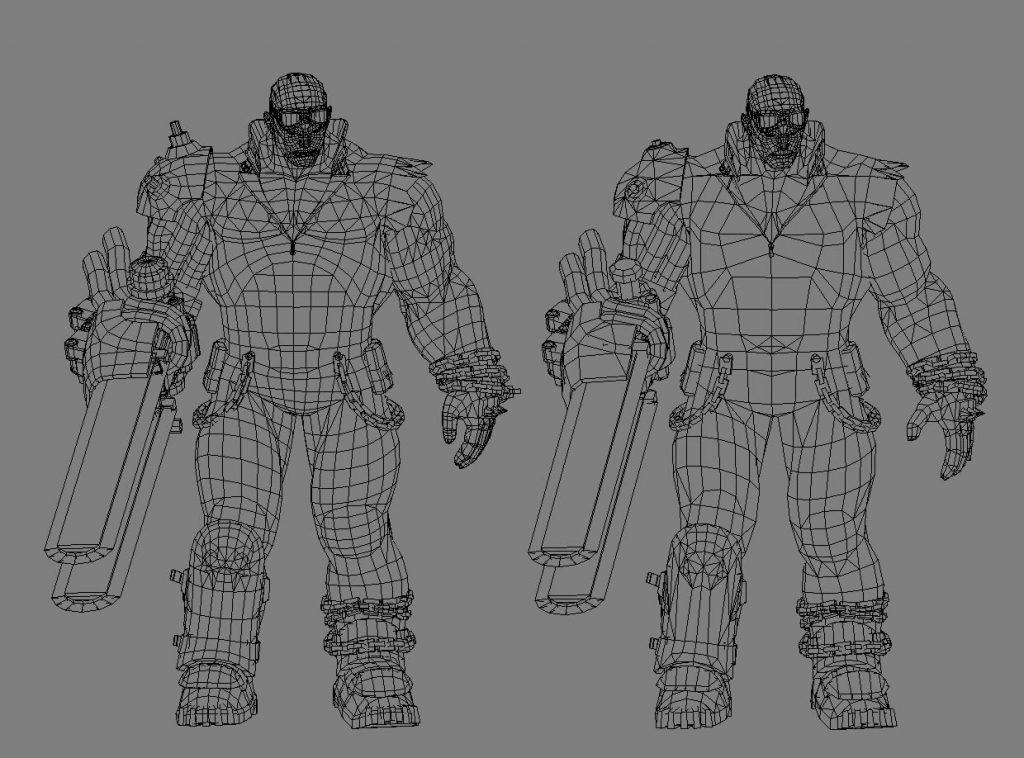Hey Everyone. My name’s Kotegawa, I handled character modeling in Anarchy Reigns.
Character modeling means taking the design “blueprints” drawn by the 2-D artists and forming them into polygon models to be used in the actual game.
Pretty much, I have to do the Frankenstein thing, over and over again. That’s my job.
Only, the original 2-D design sketches might not have what the character I need to work on looks like from the back, or even the side. So I analyze what I have, and imagine how it would look from the inside-out. To fill in the gaps, sometimes I add things myself, and sometimes I go discuss things with the original designer. When complete, I need to have a character that belongs in the world around him/her, and make the character’s design more as striking as possible.

in this picture, we’re able to see what Nikolai’s arm looks like from the inside. These detailed drawings are done by the modelers.
Furthermore, sometimes we’re met with unexpected problems when we actually put our 3-D character in the game. When this happens, I talk to the original designers to ask how we can change/redo things to help the character fit.

Rough draft image of the character. Special parts are all there.
Cleaned up image to match game specifications. But…
Character disappears in front of a dark background. Movements become hard to tell. Not good for an action game.
Since we have to keep Jack’s image color “black”, we add some silver at the ends and lose the sleeves.
Jack was the first character we made when we started the game, and the last we were polishing when we finished it.
As you know, Anarchy Reigns is a game that includes 16 different playable characters in a constant destruction frenzy. Pick one, and that character becomes your protagonist. We can’t sacrifice any quality there. In other words, we have to treat all 16 characters with the same care that most games just treat one.
Comparing it to Bayonetta, it would be like having 16 different Bayonettas or Jeannes on screen at once. Just to see, we tried 16 uncompressed Bayonetta models on our hardware with no image tricks.
…
We had nowhere near enough memory. Or processing power. Shit.
But fellow readers, did you happen to know? Models are actually changed out a lot when you’re playing a game.
Sometimes you need to change models when you zoom in for more detail: saving processing power by LOD (level of detail) is one common example. Others are, for instance:
-A scene that requires a close-up and change of expression.
-A scene where the character is doing something with his/her hands.
-In these cases, we switch out the regular fixed model with one hands or a face that can move.
If you’re able to show off smooth movement and delicate expression during these scenes, the regular model will almost surprisingly look much more high quality as well.
This is a technique we had to use to the extreme with Anarchy Reigns.
The character you see the most (in other words, the one you control) has the most detail, while the detail and movement of everything “else” (the enemy, other players) had to be cut as much as we possibly could.
Which isn’t to say we made the game 8-bit. Anarchy Reigns is a fighting game, so we know we can’t do something that would damage the look of any of the characters. If you’re punching an enemy in the face, we want you to be able to see the expression on the face. That’s one example of where we changed models. The person on our team in charge of expressions made some pretty good faces for us, so if you’re curious, be sure to look out for them. Hands were switched for taunts or special moves to bring out each character’s originality.
After all this work, finally we… still were well over our memory and processing power limits. We knew the maximum memory/processing speed output before production, but as different staff members were making different characters, the results were all over the place. Largely owing to the creators loving the characters they were in charge of too much. No one wants to have to subtract polygons from their baby. Through tests, we found the processing speed and amount and memory needed for 16 different characters vs. 16 of the same character was completely different, making it impossible to tell who was slowing things down.
So we worked out a plan.
Characters were set onto an empty field so we could gauge their memory usage and processing speeds in real time. Then we made a graph. Red signifies requirements being met, and blue means met well within bounds. New graphs were printed out and distributed every week.
 We can’t show you the specifics, but… that highlight=not good.
We can’t show you the specifics, but… that highlight=not good.
This was the beginning of a scramble for who can get the best score on the weekly graph. Even during development, Anarchy Reigns was a battle royale.
Ultimately, we had the cut the polygons of opponent characters to 1/8 what they were in Bayonetta. Which sounds insane, but owing to the techniques we mentioned, plus some normal mapping, it isn’t really noticeable.
 40% of the player’s character’s polygons were cut. Detailed design was worked out through normal mapping.
40% of the player’s character’s polygons were cut. Detailed design was worked out through normal mapping.
Favoritism developers had towards their characters showed up again when balancing character power. As the game closed in on completion, balance/bug checks were carried out on a weekly basis, and most people always used the character they were in charge of. If they felt there character was too weak, they’d go talk to the planner. It’s good to have opinions like these though, they ended up being a help.
Working as head of character modeling, I’ve learned, really attaches you to the game. That was especially true this time. It was a fighting game like my own child.
In the end, Taura, the character planning leader, and Yamanaka, the director, balance everything out so that, while there is some level of preference involved, there’s no character that’s too weak or can’t win.
We hope you can enjoy Anarchy Reigns, and maybe sense our sweet (and bittersweet) memories that went into making it.